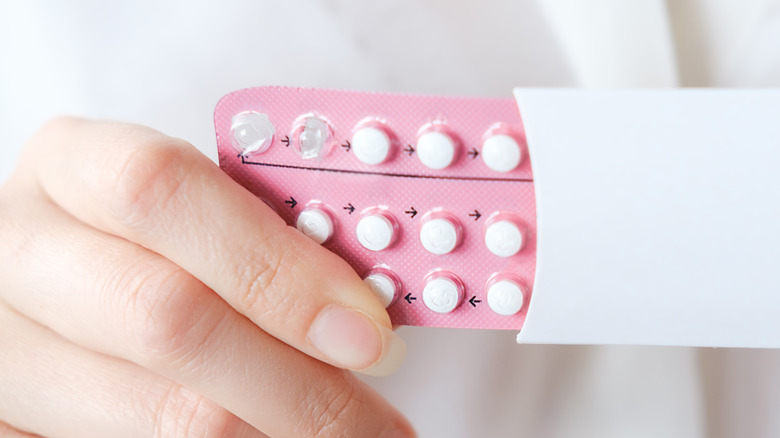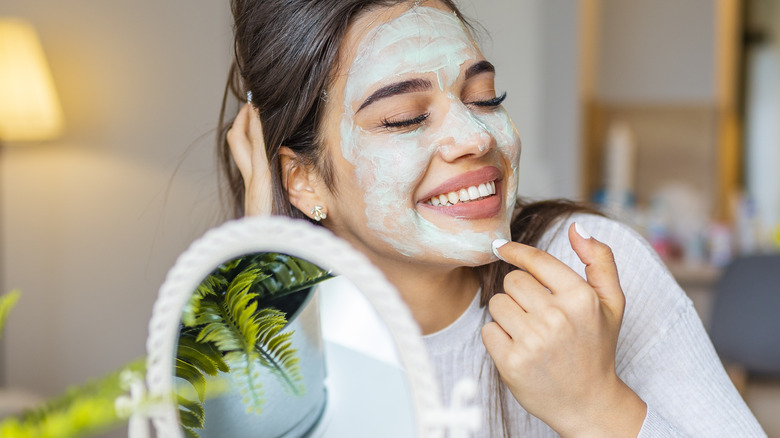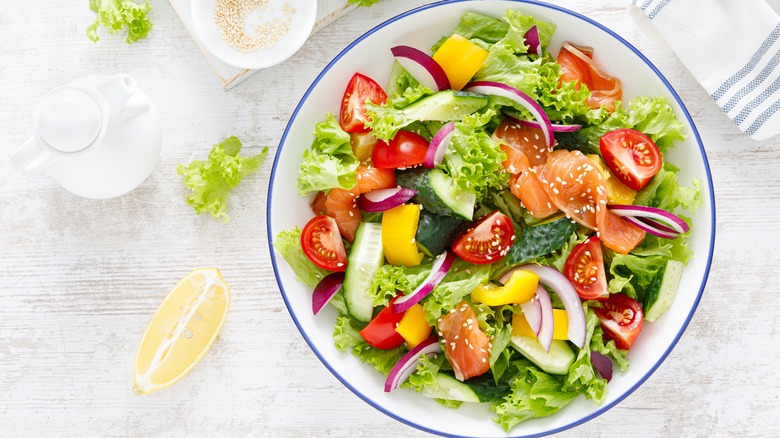Dermatologist-Recommended Solutions For Getting Rid Of Chin Acne
Adult acne can happen to anyone. In addition to the cheeks, many adults develop acne on the chin and jawline. Pimples on the chin are usually the outcome of fluctuations in the levels of hormones, such as estrogen, progesterone, and testosterone, according to Medical News Today. Hormonal imbalances are common during menstruation, pregnancy, and menopause, but can also be due to underlying medical conditions. They cause your skin to produce more sebum, resulting in clogged pores and increased acne. It's also normal to break out on the chin after exfoliating your face with a face scrub as it's part of the purging process.
According to Oliva Skin & Hair Clinic, stress, lack of sleep, poor facial hygiene, can also be the culprit of acne breakout on the lower portion of the face. Although chin acne is common and usually resolves on its own, having bumps on the face is always a pet peeve. If you're struggling with chin acne, here are some dermatologist-approved solutions to quickly get rid of it.
Avoid wearing masks for a long time
According to dermatologist Maryann Mikhail from GoodRx, wearing a mask for an extended amount of time can give you mask-related acne, also known as "maskne." Mask-related pimples are usually seen on the chin, nose bridge, cheeks, and along the jawline. Wearing tight masks for a long time can put lots of pressure on the skin and irritate the skin through constant friction. Besides, most masks are designed in such a way that they soak up the skin's natural oils, leading to dryness and causing enough inflammation to give you a flare-up. Occlusion is another reason for breakouts on the chin, since breath trapped underneath the mask causes the skin to get heated and sweaty, which leads to clogged pores and increased risks of acne.
Unless you need to wear a mask to curb the spread of a contagious virus or avoid catching one, don't wear it, especially if you have acne-prone skin. If you have to use a mask for medical reasons, try not to wear heavy makeup beneath it to avoid blocking air circulation and reduce risks of skin irritation, Scripps Health points out. If you have acne-prone skin, let your skin breathe whenever possible by washing off makeup and keeping your face clean the moment you come home.
Up your bed hygiene game
Improving your sleep hygiene can do wonders for your skin health. According to Eucalypso Home, normal cotton sheets can retain germs and sweat due to the way they are knitted. As your body releases heat during the course of your sleep, the bedding fibers trap the heat and result in additional production of sebum. Therefore, your skin has a high risk of developing acne if your pillowcases, blanket, bed spread, or bedsheet are contaminated with microorganisms.
Since your sheets can be a breeding ground for dead skin cells, sweat, and germs, make an effort to change or wash them every week or every two weeks, Ecosa points out. Pillowcases, on the other hand, need to be washed daily or every two to three days if you have oily or acne-prone skin. Also, sanitize your phone's surface with antibacterial wipes everyday and wash your hand towels daily. To minimize the risks of developing or worsening a breakout, avoid sleeping facedown on the pillow or on your side, because both positions let your chin and jawline come into direct contact with the sheets. Instead, try to sleep on your back throughout the night.
Use birth control pills
According to a study published in InformedHealth.org, inflammatory and non-inflammatory hormonal acne can be treated with birth control pills as a type of oral hormonal therapy. Birth control that contains estrogen lowers the level of testosterone in your body, which in turn leads your pores to secrete less oil and diminishes the risk of clogged pores. It might take up to three months before you see a noticeable improvement in your skin condition if you take combination birth control pills to treat acne. This is due to the fact that your body needs time to adjust to the changing hormone levels.
Yaz (drospirenone/ethinyl estradiol), Ortho Tri-Cyclen (ethinyl estradiol/norgestimate), and Estrostep FE (ethinyl estradiol/norethindrone acetate/ferrous fumarate) are three birth control medications that have been FDA-approved to treat acne in women, according to WebMD. Also, keep in mind that birth control pills must be prescribed by a nurse or a doctor, and your healthcare provider might run medical tests on you to decide if you're a good candidate for using hormonal birth control. For instance, those with a history of blood clots, migraine, or high blood pressure might not be a good fit for this type of acne treatment.
Cleanse daily and exfoliate regularly
Facial hygiene is crucial to your skin health, so take care to cleanse your face twice daily to wash excess oil, bacteria, and environmental impurities off your skin surface and keep it fresh. Going days without washing your face enables dirt and grime to build up on your skin and give you breakouts. Esthetician Renée Rouleau tells Teen Vogue, "For chin and jawline breakouts, I recommend a nondrying, sulfate-free cleanser that uses salicylic and glycolic acids." This is because glycolic acid levels out and lightens post-breakout blemishes, while salicylic acid is great at exfoliating the face and maintaining clean pores, she explains.
Exfoliating weekly with a chemical exfoliant containing glycolic or lactic acid once or twice a week is what Dr. Zenovia recommends those with chin acne. Not only are chemical exfoliants effective in sloughing away dead skin cells and keeping the pores airy, but they also reduce the inflammation of acne in the process and ward off breakouts long-term.
Use spot treatment
To get rid of breakouts on the chin quickly, dermatologist Marisa Garshick (via Prevention) recommends using spot treatments containing benzoyl peroxide or salicylic acid. Benzoyl peroxide, which is available over the counter as well as by prescription for more potent versions, is able to destroy the bacteria that cause inflammatory acne by drying up and peeling the skin. If used consistently, benzoyl peroxide can yield improvements in the skin within two weeks in those with mild or moderate acne.
Salicylic acid also stands in the league of its own when it comes to spot treatment. This powerhouse of skincare ingredient fights whiteheads and blackheads by clearing dead skin cells and gunks out of the pores and lowers sebum production. Retinoid is also among the longest-used medications to combat acne. Salicylic acid and benzoyl peroxide both work well to treat acne, but they are not comparable, and using them together might irritate the skin. Since salicylic acid is gentler than benzoyl peroxide, it's suitable for those with sensitive skin, Kiehls points out. To incorporate benzoyl peroxide and salicylic acid into your acne treatment, consider using them on alternate days. If acne is your main issue, choose spot treatments formulated with at least 1% salicylic acid or 2.5% benzoyl peroxide.
Have a low-glycemic diet
According to The American Academy of Dermatology, having a low-glycemic diet, which is foods that have little effect on your blood sugar levels, may minimize your risk of developing acne. The reason being is foods with a high glycemic index cause the blood sugar level in your body to hike, potentially triggering inflammation throughout the body and leading to acne. The way to evaluate the glycemic index (GI) in a certain type of food is to read the GI symbol on food packaging. For instance, a low GI rank is from 1 to 55, while a medium GI ranks from 56 to 69. Anything rated above 70 — like white rice, white bread, and processed food — is considered high on the GI index.
Adopting a low-GI diet typically means swapping a high-carb eating regimen for a fiber-rich, whole grain-filled alternative including veggies, fruits, raw carrots, chickpeas, and lentils, according to Mayo Clinic. Baked chicken breast, scrambled eggs, smoked or grilled salmon, stir-fried beef, whole wheat bread, and low-fat yogurt are some tasty options for a low-GI diet. Avoid bottled juice, even freshly squeezed ones, as these can cause severe breakouts. Instead, choose vegetable juice made from parsley, dandelion greens, kale, celery, fennel, and cucumbers. Not only does a low-GI diet help prevent acne, but it also aids in weight loss and reduces risks of diabetes and heart diseases.
Avoid stress triggers
Stress, anxiety, and fear cannot give you breakouts, but they can worsen your acne if you're already vulnerable to it, warns dermatologist Dr. John Minni from Water's Edge Dermatology. He explains: "When your fight-or-flight response is activated, the body releases stress hormones, such as cortisol and androgens." As a result, these hormones stimulate your skin's oil production, which can make your breakout worse. Stress is inevitable, but you can keep your stress level under control by gradually developing stress-relief habits. For instance, engaging in a physical activity at least three times per week, setting at least one night per week to completely unwind from work, and doing charitable work regularly can work wonders in averting your mind away from your emotional burden and lifting your spirit.
Also, give a wide berth to highly processed food, especially when you're already struggling with both stress and acne. According to dietitian Karen Hemmes from Banner – University Medical Center Phoenix, processed meats, sugary dishes, caffeine, and alcoholic drinks have been shown to be linked to a hike in psychiatric symptoms and to be able to shoot up the levels of cortisol, your body's primary stress hormone. Meanwhile, a nutritious diet loaded with fruits, veggies, lean proteins, whole grains, and healthy fats can aid in bringing down the stress level, says Hemmes. For stress-relieving midday pick-me-up, reach for coconut juice, chamomile tea, ginger tea, and dark chocolate.







